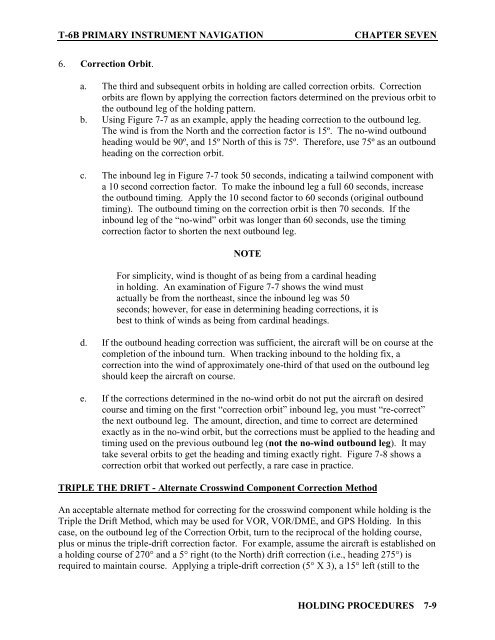Flight Training Instruction - Cnatra - U.S. Navy
Flight Training Instruction - Cnatra - U.S. Navy
Flight Training Instruction - Cnatra - U.S. Navy
You also want an ePaper? Increase the reach of your titles
YUMPU automatically turns print PDFs into web optimized ePapers that Google loves.
T-6B PRIMARY INSTRUMENT NAVIGATION CHAPTER SEVEN<br />
6. Correction Orbit.<br />
a. The third and subsequent orbits in holding are called correction orbits. Correction<br />
orbits are flown by applying the correction factors determined on the previous orbit to<br />
the outbound leg of the holding pattern.<br />
b. Using Figure 7-7 as an example, apply the heading correction to the outbound leg.<br />
The wind is from the North and the correction factor is 15º. The no-wind outbound<br />
heading would be 90º, and 15º North of this is 75º. Therefore, use 75º as an outbound<br />
heading on the correction orbit.<br />
c. The inbound leg in Figure 7-7 took 50 seconds, indicating a tailwind component with<br />
a 10 second correction factor. To make the inbound leg a full 60 seconds, increase<br />
the outbound timing. Apply the 10 second factor to 60 seconds (original outbound<br />
timing). The outbound timing on the correction orbit is then 70 seconds. If the<br />
inbound leg of the “no-wind” orbit was longer than 60 seconds, use the timing<br />
correction factor to shorten the next outbound leg.<br />
NOTE<br />
For simplicity, wind is thought of as being from a cardinal heading<br />
in holding. An examination of Figure 7-7 shows the wind must<br />
actually be from the northeast, since the inbound leg was 50<br />
seconds; however, for ease in determining heading corrections, it is<br />
best to think of winds as being from cardinal headings.<br />
d. If the outbound heading correction was sufficient, the aircraft will be on course at the<br />
completion of the inbound turn. When tracking inbound to the holding fix, a<br />
correction into the wind of approximately one-third of that used on the outbound leg<br />
should keep the aircraft on course.<br />
e. If the corrections determined in the no-wind orbit do not put the aircraft on desired<br />
course and timing on the first “correction orbit” inbound leg, you must “re-correct”<br />
the next outbound leg. The amount, direction, and time to correct are determined<br />
exactly as in the no-wind orbit, but the corrections must be applied to the heading and<br />
timing used on the previous outbound leg (not the no-wind outbound leg). It may<br />
take several orbits to get the heading and timing exactly right. Figure 7-8 shows a<br />
correction orbit that worked out perfectly, a rare case in practice.<br />
TRIPLE THE DRIFT - Alternate Crosswind Component Correction Method<br />
An acceptable alternate method for correcting for the crosswind component while holding is the<br />
Triple the Drift Method, which may be used for VOR, VOR/DME, and GPS Holding. In this<br />
case, on the outbound leg of the Correction Orbit, turn to the reciprocal of the holding course,<br />
plus or minus the triple-drift correction factor. For example, assume the aircraft is established on<br />
a holding course of 270° and a 5° right (to the North) drift correction (i.e., heading 275°) is<br />
required to maintain course. Applying a triple-drift correction (5° X 3), a 15° left (still to the<br />
HOLDING PROCEDURES 7-9
















